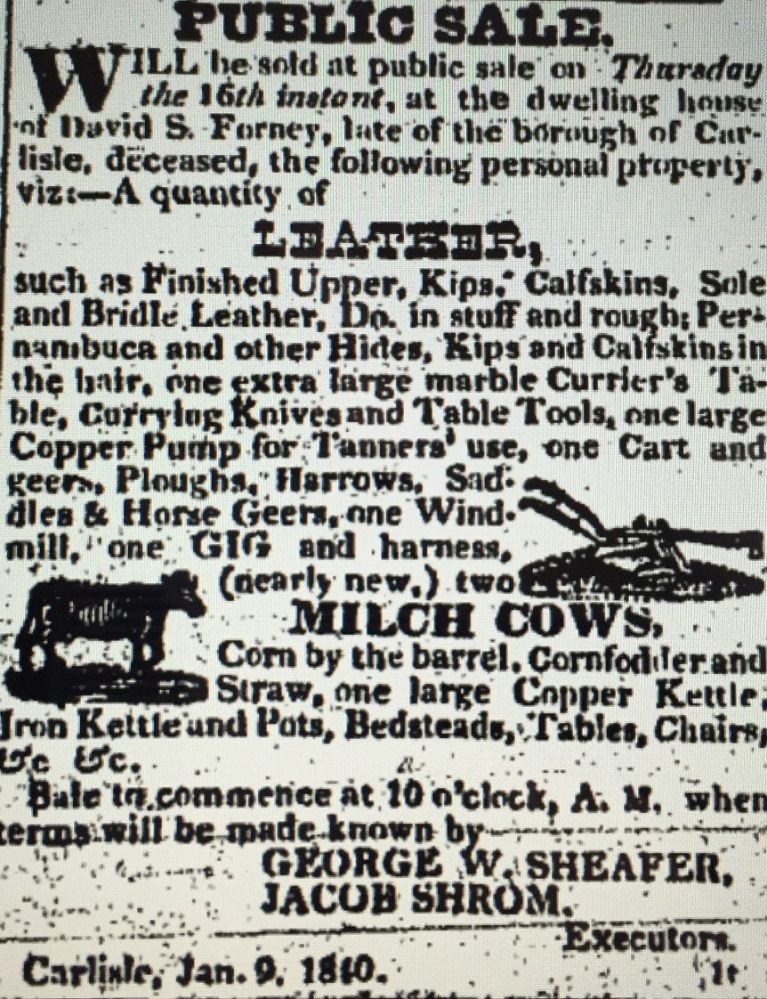Tanner David S. Forney was born on November 4, 1787 to Adam Forney and his wife Rachel Shriver.1 David’s father Adam, a tanner, was an early settler in the Hanover, Pennsylvania area.
When David was young, according to his daughter Mary Roland, he worked “in a leather store in Baltimore. While thus employed, he formed the acquaintance of Mr. Zinn of Harrisburg and accepted the offer of a partnership in his tannery. He subsequently married Mr. Zinn’s only daughter Elizabeth (in 1812). They had two children, John Zinn and Catharine.”2
Forney’s wife died, and in 1818 he married Elizabeth Decker of Maryland. They settled in Carlisle where Elizabeth’s sister, Margaret, and her husband Jacob Crever, Jr. lived.3 In 1819, Forney bought Lots #337 and #338, located on the corner of East Louther and East streets, at a sheriff sale.4
Because tanners needed a source of water, Carlisle’s tanneries were located on the East street lots that backed onto the LeTort stream. All of the lots in the block between Mulberry Alley and East Louther streets were tanyards as well as Forney’s property.
Forney operated his tannery for twenty years. He died on Christmas Eve in 1839.5 He was ill when he made his will in November 1839. He left his wife Elizabeth the household goods, etc. and $275 a year for life unless she remarried. He instructed that his executors sell his tanyard as soon as possible after his death. His lot on Hanover Street, “on which Mr. Shaeffer now lives,” was not to be sold for six years. He mentioned children Mary, Elizabeth and Jacob. Mary was to have the piano forte for which she was to be charged $100 out of her share of his estate. He mentioned money that children John and Catharine received from their grandfather’s estate.6
A public sale of Forney’s personal property was held at his dwelling house on January 16, 1840. The advertisement for the sale listed viz:
“a quantity of leather such as finished upper, kips, calfskins, sole and riddle leather, ditto in stuff and rough, Pernambuca and other hides, kips and calfskins in the hair, one extra large marble currier’s table, currying knives and table tools, one large copper pump for tanners use, one cart and geers, ploughs, harrows, saddles and horse geers, one windmill, one gig and harness (nearly new), two milch cows, corn by the barrel, corn fodder and straw, one large copper kettle, iron kettle and pots, bedsteads, tables, chairs, etc.”7
Forney’s tanyard property was sold at a public sale on November 6, 1840. The property consisted of “a large two-story stone dwelling house, a two-story stone finishing shop, a large two-story brick beam house, a large frame bark and mill house with a bark mill in it. There were 44 layaways and a pool in the yard, 5 handlers, 3 limes and 1 bate in the beam house and a good well of water at the door.” Chestnut and black oak board and tanners’ tools were also sold.8
Forney’s wife Elizabeth moved to York, Pennsylvania after her husband’s death. She died on January 31, 1886 and is buried in Prospect Hill Cemetery with her husband David.

